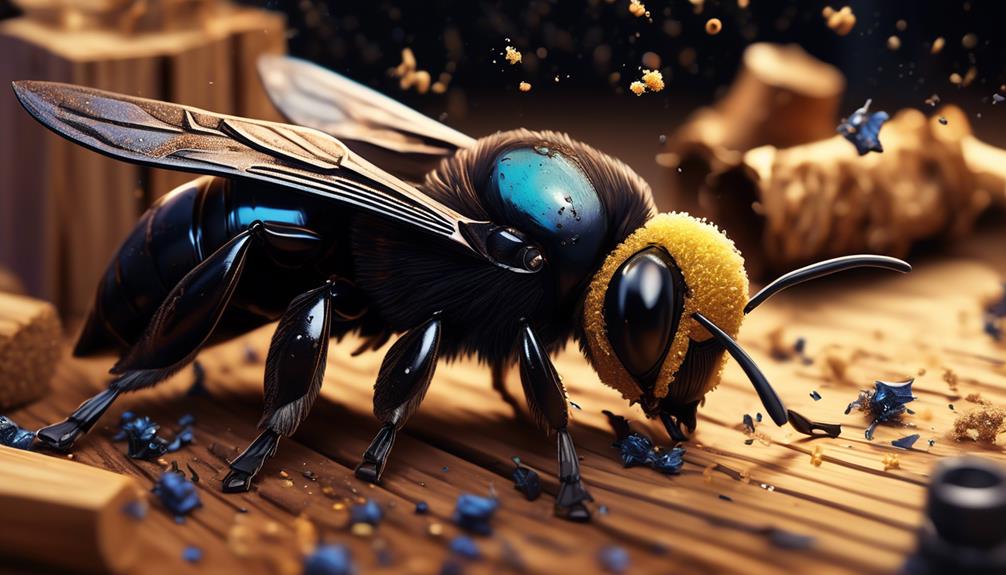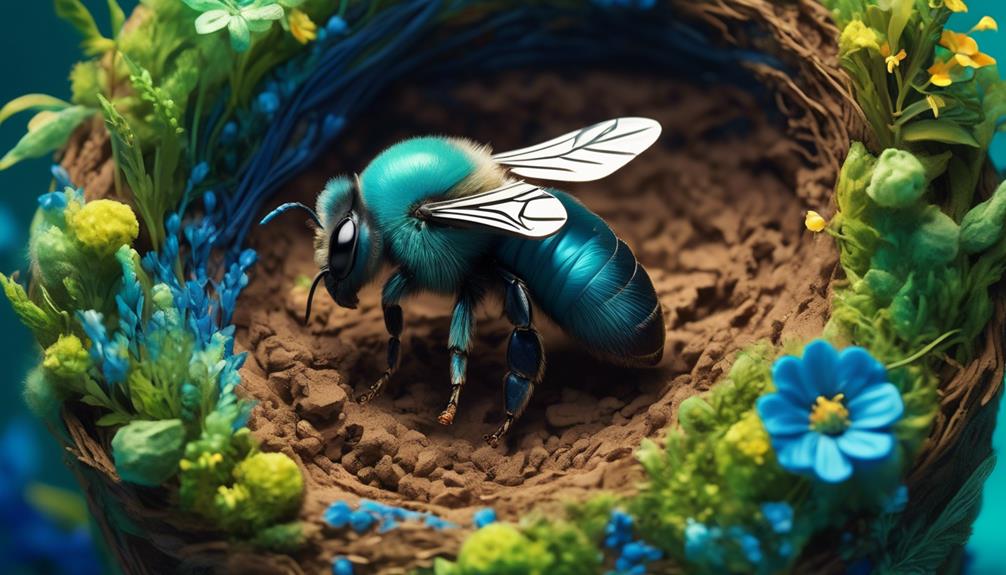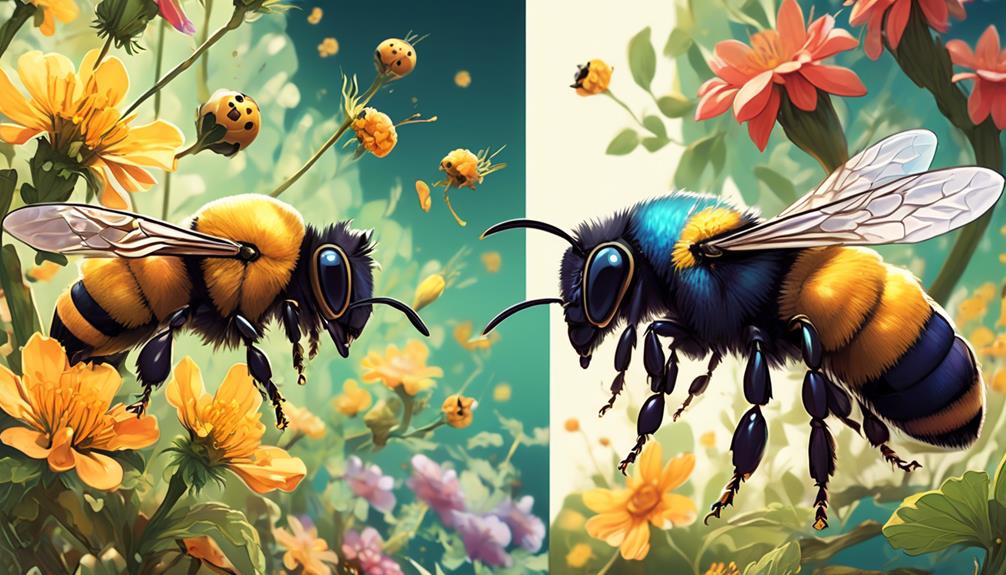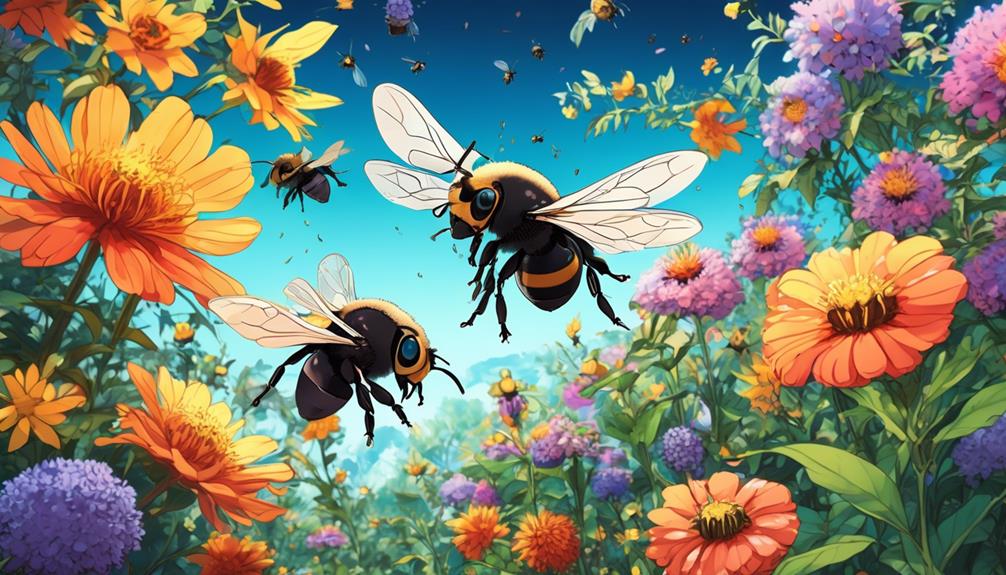Dive into the intriguing world of carpenter and mason bees and discover how they're different, yet equally vital to our ecosystem.

Are Carpenter and Mason Bees the Same Thing
Did you know that there are over 20,000 different species of bees worldwide?
Among these multitudes, two types that often cause confusion are carpenter bees and mason bees. You might assume they're the same, given their similar names suggesting industrious nature, but is that really the case?
While they both play pivotal roles in our ecosystem, there are intriguing differences and similarities that you might not be aware of.
So, let's sift through the buzz and uncover the intriguing world of these two fascinating bee types.
Key Takeaways
- Carpenter bees and mason bees are both fascinating creatures with unique nesting habits.
- Carpenter bees bore into wood to create tunnels for their larvae, while mason bees use mud and small cavities for nesting.
- Carpenter bees can cause structural damage if left unchecked, while mason bees are efficient pollinators that boost fruit and vegetable yields.
- Carpenter bees are solitary and aggressive when threatened, while mason bees are more social, docile, and rarely sting.
Understanding Carpenter Bees

Let's dive into the world of Carpenter Bees, intriguing insects recognized for their ability to bore into wood and live a largely solitary lifestyle. Unlike the social honey or bumble bees, Carpenter Bees are solitary creatures. They're named for their woodworking skills. With strong jaws, they can carve tunnels into wood, creating perfect homes for their larvae. It's fascinating, isn't it?
Now, you might be wondering, do these bees damage your home? Well, individual holes mightn't be a big deal, but over time, if unchecked, they can cause some structural damage. They're not aggressive insects, but the females can sting if they feel threatened. So, it's best you keep a respectful distance.
In terms of appearance, they're often mistaken for bumblebees due to their size and color. However, their abdomen is shiny and black, lacking the bumblebee's hairy body. You'll often spot them in spring and summer, buzzing around wooden structures.
Mason Bees: An Overview

Shifting gears to Mason Bees, these are equally fascinating insects known for their unique nesting habits, often using mud to construct their homes, hence the name. Unlike their carpenter counterparts, they're not wood-borers. Instead, they prefer to nest in small cavities, like hollow stems or pre-existing holes in wood, which they line with mud to create cells for their offspring.
These solitary bees don't live in colonies like honeybees. Each female is fertile and makes her own nest. They're also non-aggressive and will only sting if threatened or handled roughly.
It's noteworthy that Mason bees are some of the most efficient pollinators around. In fact, just a few of these bees can pollinate as many flowers as several thousand honeybees. They're excellent for boosting fruit and vegetable yields, making them a favorite among gardeners and farmers.
Their brilliant blue or green metallic bodies make them easily distinguishable. They're also active earlier in the year than many bees, often being seen as early as March.
Understanding these bees and their habits is crucial due to their significant role in pollination. By providing them with suitable nesting sites, you're contributing to the environment's wellbeing.
Comparing Physical Characteristics

Diving into the physical characteristics, you'll find noticeable differences between Carpenter and Mason bees that extend beyond their nesting habits. Carpenter bees are typically larger, often resembling bumblebees with their robust, fuzzy bodies. Their upper abdomen is shiny, predominantly black, and hairless, while their lower half is covered with yellow or white hairs.
Mason bees, on the other hand, are smaller and not as hairy. They're usually metallic green or blue, giving them a distinctive and captivating appearance. Unlike the Carpenter bees, Mason bees have hairs on their abdomen, often making them appear dusty.
When it comes to the structure of their antennae, you'll find another point of divergence. Carpenter bees have long, curved antennae, while those of Mason bees are shorter and straighter. This distinction aids in their specific foraging and nesting behaviors.
Their wings also differ, with Carpenter bees owning darker wings while Mason bees sport clear or lightly colored wings. These physical characteristics aren't just fascinating trivia. They're essential for identification and understanding the unique roles these bees play in our ecosystem.
Behavioral Differences Explored

Beyond these physical distinctions, you'll notice significant behavioral differences between Carpenter and Mason bees that further underscore their unique roles in our environment.
Carpenter bees, for instance, are solitary creatures. They prefer to nest in wood, creating perfectly round holes for their offspring. They're also known for their aggressive behavior when threatened, but it's important to note that only females have the ability to sting.
Mason bees, on the other hand, are more social. They often share nesting sites in existing holes in wood or in the ground, and are known for their industrious behavior, using mud to construct their nests. Unlike Carpenter bees, Mason bees are docile and rarely sting unless they feel threatened.
Here's a table summarizing these behavioral differences:
Behavior | Carpenter Bees | Mason Bees |
|---|---|---|
Nesting Preferences | Solitary in wood | Communal in existing holes |
Aggression | Aggressive; females can sting | Docile; rarely sting |
Nest Construction | Create holes in wood | Use mud for construction |
In general, both of these bees play pivotal roles in pollination. However, their contrasting behaviors offer a fascinating insight into the diverse world of bees.
Impact on Ecosystem and Pollination

You might be wondering about the role these bees play in our ecosystem, particularly their contribution to pollination. Well, both carpenter and mason bees are vital players in our environmental health. Unlike honeybees that focus on mass pollination, these solitary bees specialize in precision pollination. They're known for their 'buzz pollination', a process where they vibrate their bodies at a frequency that releases pollen stuck in flowers. This not only ensures a higher rate of fertilization but also improves the genetic diversity of plants.
Without these bees, your backyard might look less vibrant, and our food system might struggle. They're crucial for pollinating wild plants and crops, including fruits and vegetables we consume daily. Also, by nesting in dead trees and plant stems, they play an essential role in nutrient recycling, contributing to soil health.
However, their populations are declining due to habitat loss and pesticide exposure. It's our responsibility to provide safe habitats and limit pesticide use to protect these unsung heroes of our ecosystem. By doing so, we're not only preserving biodiversity but also securing our food supply. Understand, the impact of these bees reach far beyond their small size.
Frequently Asked Questions
What Are the Common Predators of Carpenter and Mason Bees?
No, carpenter and mason bees aren't the same thing. Carpenter bees bore into wood to nest, while mason bees use existing holes and seal them with mud.
They both have common predators, though. You'll find birds, spiders, and wasps preying on these bees. Even some mammals, like skunks and bears, will raid their nests.
How Can I Attract Carpenter and Mason Bees to My Backyard?
No, carpenter and mason bees aren't the same thing. While they share similarities, they're different species.
Carpenter bees tend to be larger and burrow into wood to nest, causing possible damage.
Mason bees, however, use existing holes and cavities, often sealing their nests with mud.
They're both important pollinators, but their nesting habits and behaviors set them apart.
What Are the Primary Health Risks or Allergies Associated With Carpenter and Mason Bees?
You're unlikely to experience health risks or allergies from Carpenter and Mason bees. They're non-aggressive and rarely sting unless threatened. However, if you're allergic to bee stings, you could have a reaction.
Carpenter bees can cause structural damage to untreated wood. But, remember, they're beneficial for pollination.
It's always smart to wear protective clothing when near their habitats if you're concerned about potential issues.
Are There Any Specific Regions or Climates Where Carpenter and Mason Bees Are More Prevalent?
No, Carpenter and Mason bees aren't the same thing. They're both solitary bees but they've different behaviors.
Carpenter bees bore into wood to make their nests, which can cause damage to structures.
Mason bees, on the other hand, use existing holes and cavities, often sealing their nests with mud.
Despite these differences, both are important pollinators and generally harmless to humans.
What Are the Laws and Regulations Regarding the Protection or Extermination of Carpenter and Mason Bees?
You're asking about the legalities around carpenter and mason bees. Laws vary widely. In some areas, they're protected due to their pollination role. Extermination is often discouraged unless they pose a significant threat. It's always crucial to check local regulations.
Conclusion
So, you've learned that carpenter and mason bees aren't the same thing after all. Physically, they vary from each other and their behavior is pretty unique too.
They both play crucial roles in our ecosystem, with their pollination efforts aiding in the growth of plants. Understanding their differences helps us appreciate their individual contributions to our environment.
Remember, every little creature plays a significant part in the grand scheme of things.



